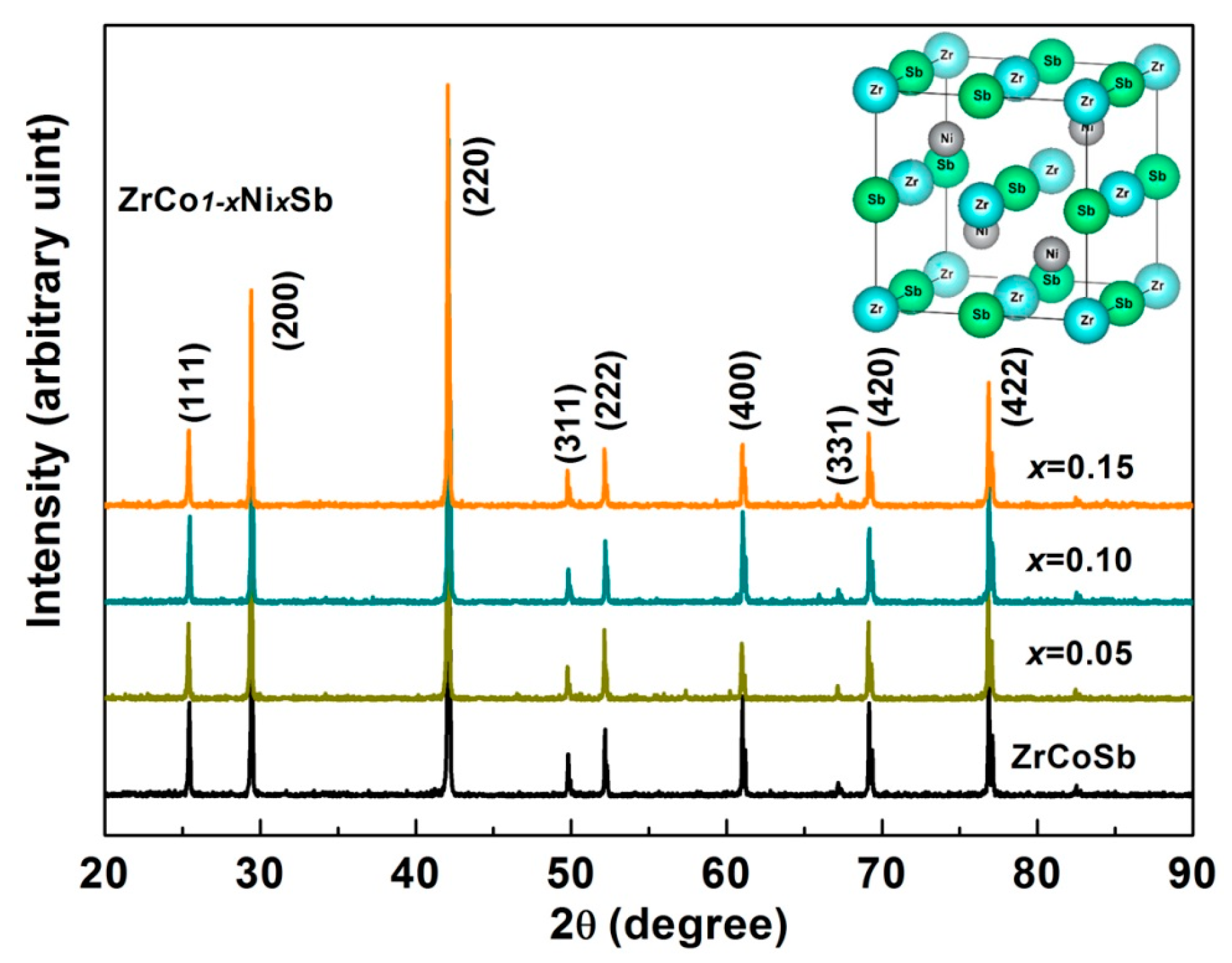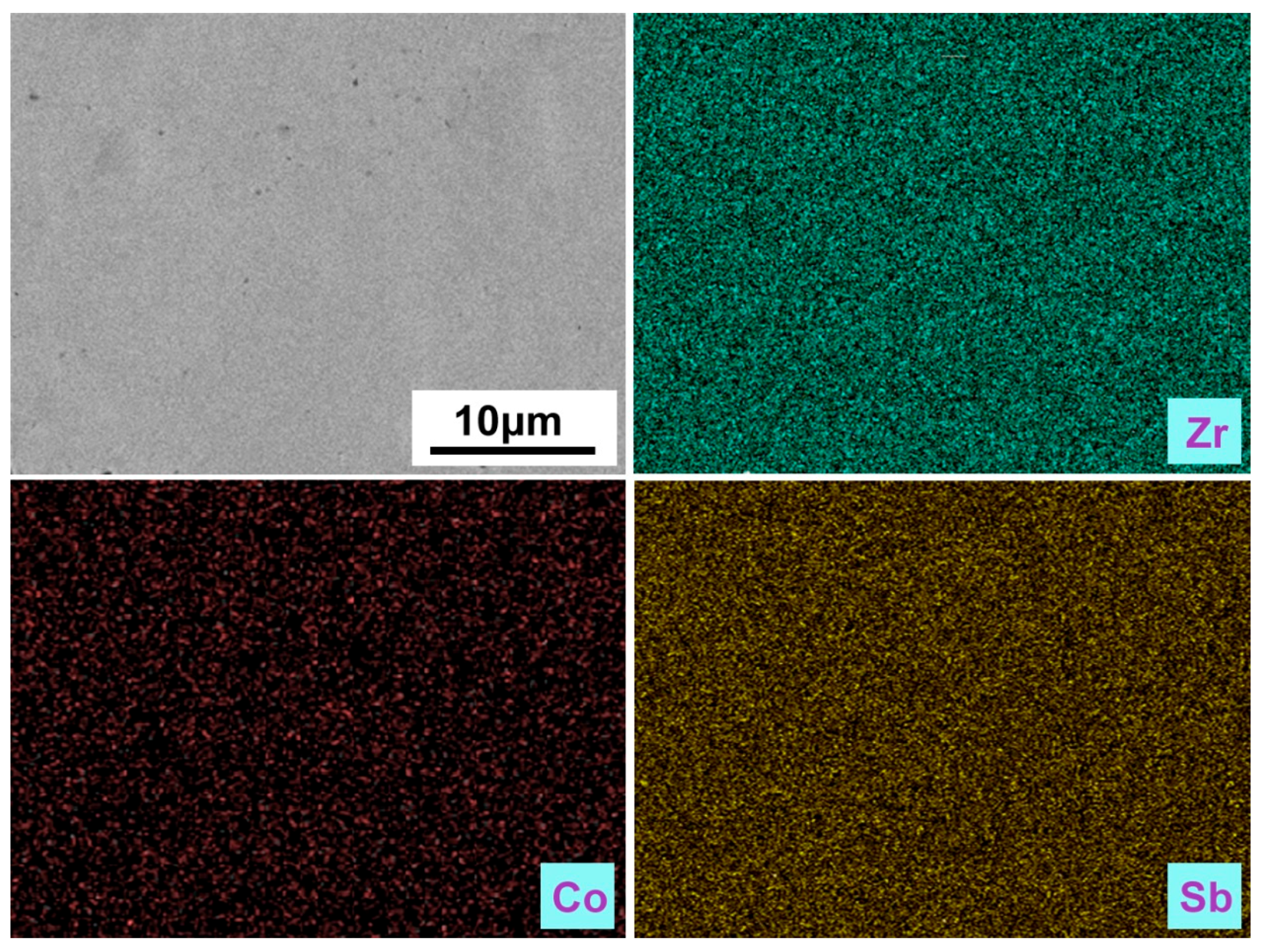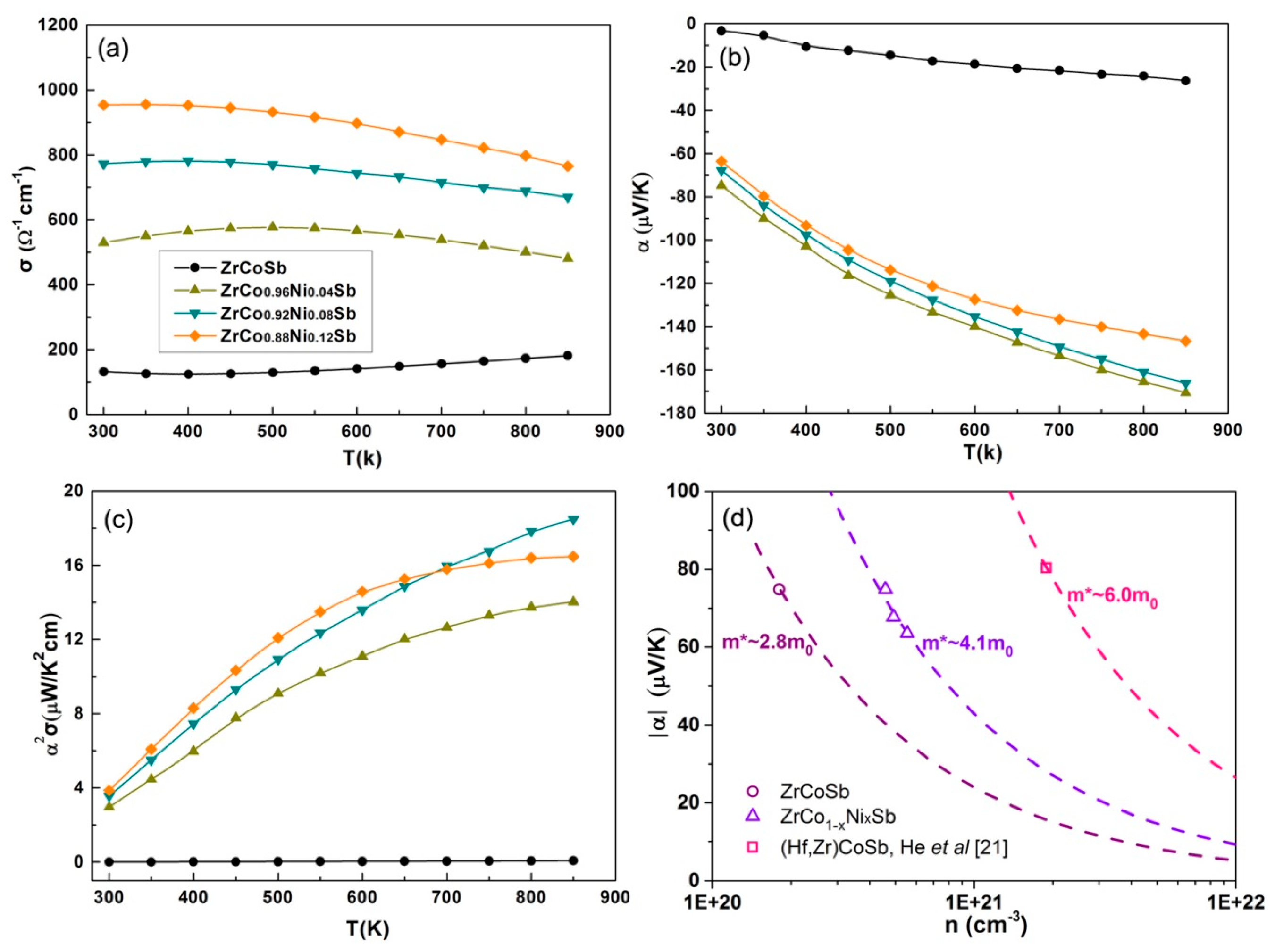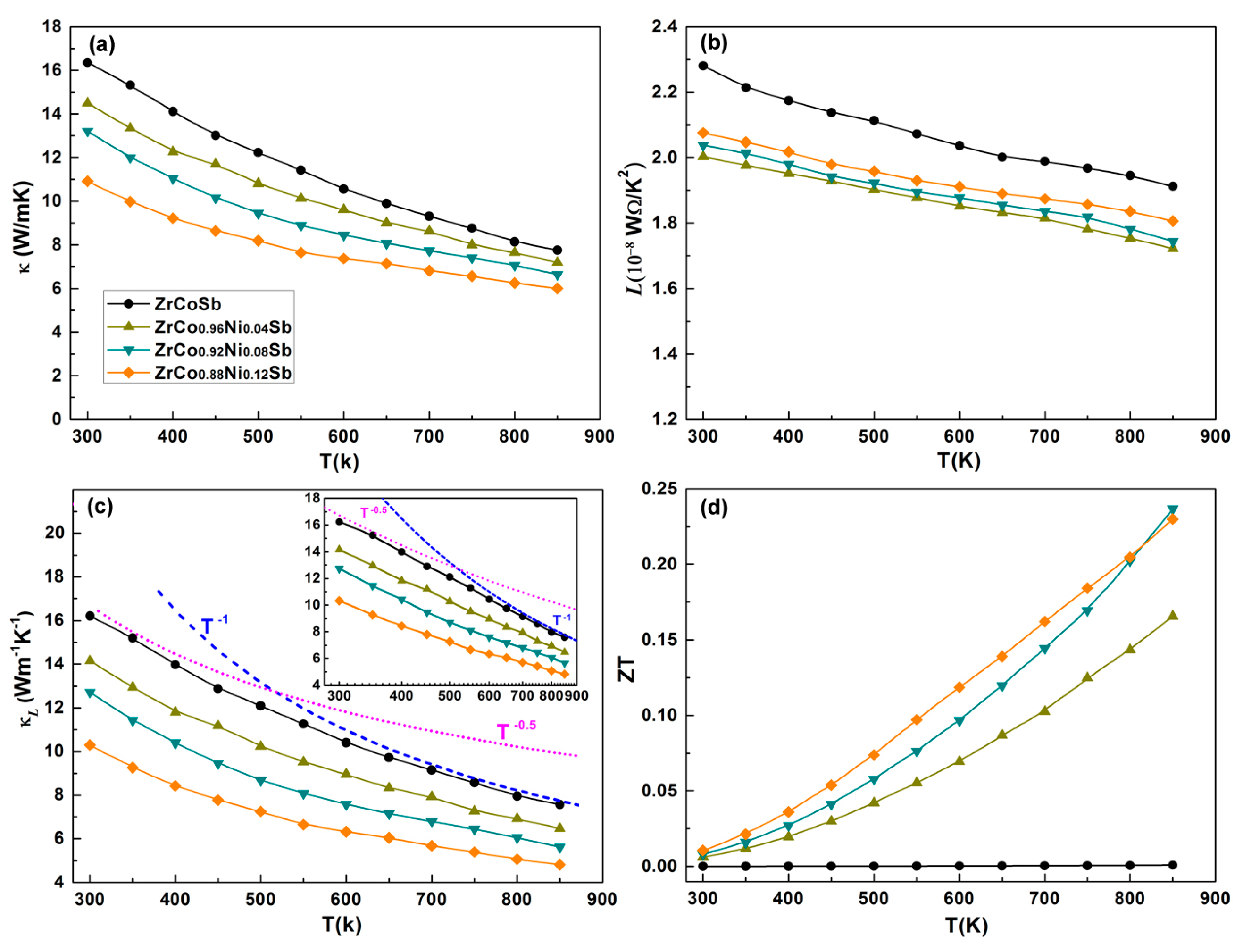Synthesis and Thermoelectric Properties of Ni-Doped ZrCoSb Half-Heusler Compounds
Abstract
:1. Introduction
2. Experimental Procedures
3. Results and Discussion
4. Conclusions
Acknowledgments
Author Contributions
Conflicts of Interest
References
- Ding, L.C.; Akbarzadeh, A.; Tan, L. A review of power generation with thermoelectric system and its alternative with solar ponds. Renew. Sustain. Energy Rev. 2018, 81, 799–812. [Google Scholar] [CrossRef]
- Fitriani, R.O.; Long, B.D.; Barma, M.C.; Riaz, M.; Sabri, M.F.; Said, S.M.; Saidur, R. A review on nanostructures of high temperature thermoelectric materials for waste heat recovery. Renew. Sustain. Energy Rev. 2016, 64, 635–659. [Google Scholar] [CrossRef]
- Cao, Q.M.; Luan, W.L.; Wang, T.C. Performance enhancement of heat pipes assisted thermoelectric generator for automobile exhaust heat recovery. Appl. Therm. Eng. 2018, 130, 1472–1479. [Google Scholar] [CrossRef]
- Champier, D. Thermoelectric generators: A review of applications. Energy Convers. Manag. 2017, 140, 167–181. [Google Scholar] [CrossRef]
- Sajid, M.; Hassan, I.; Rahman, A. An overview of cooling of thermoelectric devices. Renew. Sustain. Energy Rev. 2017, 78, 15–22. [Google Scholar] [CrossRef]
- Liu, W.L.; Hu, J.Z.; Zhang, S.M.; Deng, M.J.; Han, C.G.; Liu, Y. New trends, strategies and opportunities in thermoelectric materials: A perspective. Mater. Today Phys. 2017, 1, 50–60. [Google Scholar] [CrossRef]
- Elghool, A.; Basrawi, F.; Ibrahim, T.K.; Habib, K.; Ibrahim, H.; Idris, D.M. A review on heat sink for thermo-electric power generation: Classifications and parameters affecting performance. Energy Convers. Manag. 2017, 134, 260–277. [Google Scholar] [CrossRef]
- Xue, Q.Y.; Liu, H.J.; Fan, D.D.; Cheng, L.; Zhao, B.Y.; Shi, J. LaPtSb: A half-Heusler compound with high thermoelectric performance. Phys. Chem. Chem. Phys. 2016, 18, 17912–17916. [Google Scholar] [CrossRef] [PubMed]
- Bhattacharya, S.; Madsen, G.K.H. A novel p-type half-Heusler from high-throughput transport and defect calculations. J. Mater. Chem. C 2016, 4, 11261–11268. [Google Scholar] [CrossRef]
- Chauhan, N.S.; Bhardwaj, A.; Senguttuvan, T.D.; Pant, R.P.; Mallik, R.C.; Misra, D.K. A synergistic combination of atomic scale structural engineering and panoscopic approach in p-type zrcosb-based half-Heusler thermoelectric materials for achieving high ZT. J. Mater. Chem. C 2016, 4, 5766–5778. [Google Scholar] [CrossRef]
- Fu, C.G.; Zhu, T.J.; Liu, Y.T.; Xie, H.H.; Zhao, X.B. Band engineering of high performance p-type FeNbSb based half-Heusler thermoelectricmaterials for figure of merit ZT > 1. Energy Environ. Sci. 2015, 8, 216–223. [Google Scholar] [CrossRef]
- Kangsabanik, J.V.; Alam, A.E. Bismuth based Half Heusler alloys with giant thermoelectric figure of merit. J. Mater. Chem. A 2016, 5, 6131–6139. [Google Scholar]
- Downie, R.A.; Barczak, S.; Smith, R.; Bos, J.W. Compositions and thermoelectric properties of XNiSn (X = Ti, Zr, Hf) half-Heusler alloys. J. Mater. Chem. C 2015, 3, 10534–10542. [Google Scholar] [CrossRef]
- Rausch, E.; Balke, B.; Ouardi, S.; Felser, C. Enhanced thermoelectric performance in the p-type half-Heusler (Ti/Zr/Hf)CoSb0.8Sn0.2 system via phase separation. Phys. Chem. Chem. Phys. 2014, 16, 25258–25262. [Google Scholar] [CrossRef] [PubMed]
- Yuan, B.; Wang, B.; Huang, L.; Lei, X.; Zhao, L.; Wang, C. Effects of Sb substitution by Sn on the thermoelectric properties of ZrCoSb. J. Electron. Mater. 2016, 46, 3076–3083. [Google Scholar] [CrossRef]
- Hsu, C.C.; Ma, H.K. Microstructure and thermoelectric properties in Fe-doped ZrCoSb half-Heusler compounds. Mater. Sci. Eng. B 2015, 198, 80–85. [Google Scholar] [CrossRef]
- He, R.; Zhu, H.; Sun, J.; Mao, J.; Reith, H.; Chen, S. Improved thermoelectric performance of n-type half-Heusler MCo1−xNixSb (M = Hf, Zr). Mater. Today Phys. 2017, 1, 24–30. [Google Scholar] [CrossRef]
- Silpawilawan, W.; Kurosaki, K.; Ohishi, Y.; Muta, H.; Yamanaka, S. FeNbSb p-type half-Heusler compound: Beneficial thermomechanical properties and high-temperature stability for thermoelectrics. J. Mater. Chem. C 2017, 5, 6677–6681. [Google Scholar] [CrossRef]
- Rausch, E.; Balke, B.; Stahlhofen, J.M.; Ouardi, S.; Burkhardt, U.; Felser, C. Fine tuning of thermoelectric performance in phase-separated half-Heusler compounds. J. Mater. Chem. C 2015, 3, 10409–10414. [Google Scholar] [CrossRef]
- Romaka, V.V.; Romaka, L.; Rogl, P.; Stadnyk, Y.; Melnychenko, N.; Korzh, R. Peculiarities of thermoelectric half-Heusler phase formation in Zr-Co-Sb ternary system. J. Alloys Compd. 2014, 585, 448–454. [Google Scholar] [CrossRef]
- Schmitt, J.; Gibbs, Z.; Snyder, G.J.; Felser, C. Resolving the true band gap of ZrNiSn half-Heusler thermoelectric materials. Mater. Horiz. 2014, 2, 68–75. [Google Scholar] [CrossRef]
- Huang, L.H.; Zhang, Q.Y.; Wang, Y.M.; He, R.; Shuai, J.; Zhang, J.J. The effect of Sn doping on thermoelectric performance of n-type half-Heusler NbCoSb. Phys. Chem. Chem. Phys. 2017, 134, 25683–25690. [Google Scholar] [CrossRef] [PubMed]
- Downie, R.A.; Maclaren, D.A.; Bos, J.W. Thermoelectric performance of multiphase XNiSn (X = Ti, Zr, Hf) half-Heusler alloys. J. Mater. Chem. A 2014, 2, 6107–6114. [Google Scholar] [CrossRef] [Green Version]
- Liu, Y.F.; Poudeu, P.F. Thermoelectric properties of Ge doped n-type TixZr1−xNiSn0.975Ge0.025 half-Heusler alloys. J. Mater. Chem. A 2015, 3, 12507–12514. [Google Scholar] [CrossRef]




| x | Relative Density | σ (Ω−1·cm−1) | n (1020 cm−3) | μH (cm2/Vs) | α (μV/K) | κL (Wm−1·K−1) | m* (m0) |
|---|---|---|---|---|---|---|---|
| 0 | 98.5% | 146 | 1.80 | 5.08 | −3.4 | 16.2 | 2.80 |
| 0.04 | 98.4% | 529 | 4.59 | 7.20 | −74.8 | 14.2 | 4.08 |
| 0.08 | 98.8% | 773 | 4.92 | 9.82 | −67.7 | 12.7 | 4.09 |
| 0.12 | 98.6% | 954 | 5.55 | 10.7 | −63.5 | 10.3 | 4.11 |
© 2018 by the authors. Licensee MDPI, Basel, Switzerland. This article is an open access article distributed under the terms and conditions of the Creative Commons Attribution (CC BY) license (http://creativecommons.org/licenses/by/4.0/).
Share and Cite
Zhao, D.; Wang, L.; Bo, L.; Wu, D. Synthesis and Thermoelectric Properties of Ni-Doped ZrCoSb Half-Heusler Compounds. Metals 2018, 8, 61. https://doi.org/10.3390/met8010061
Zhao D, Wang L, Bo L, Wu D. Synthesis and Thermoelectric Properties of Ni-Doped ZrCoSb Half-Heusler Compounds. Metals. 2018; 8(1):61. https://doi.org/10.3390/met8010061
Chicago/Turabian StyleZhao, Degang, Lin Wang, Lin Bo, and Di Wu. 2018. "Synthesis and Thermoelectric Properties of Ni-Doped ZrCoSb Half-Heusler Compounds" Metals 8, no. 1: 61. https://doi.org/10.3390/met8010061




